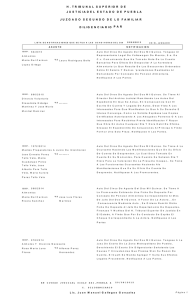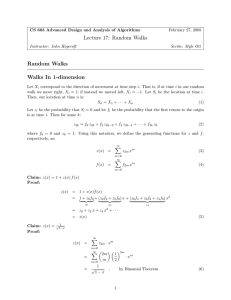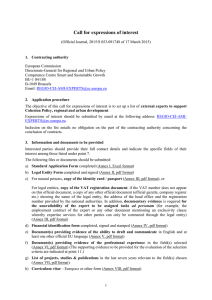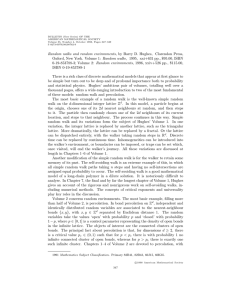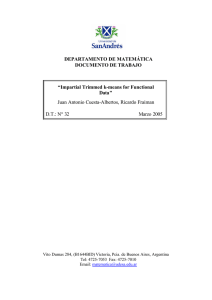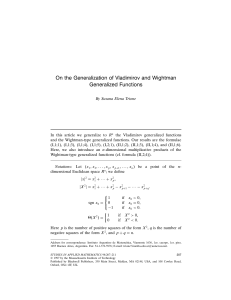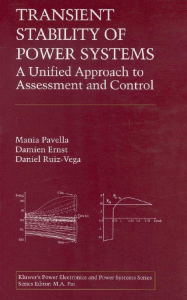MINI-COURSE ON RANDOM WALK IN RANDOM ENVIRONMENT
Anuncio
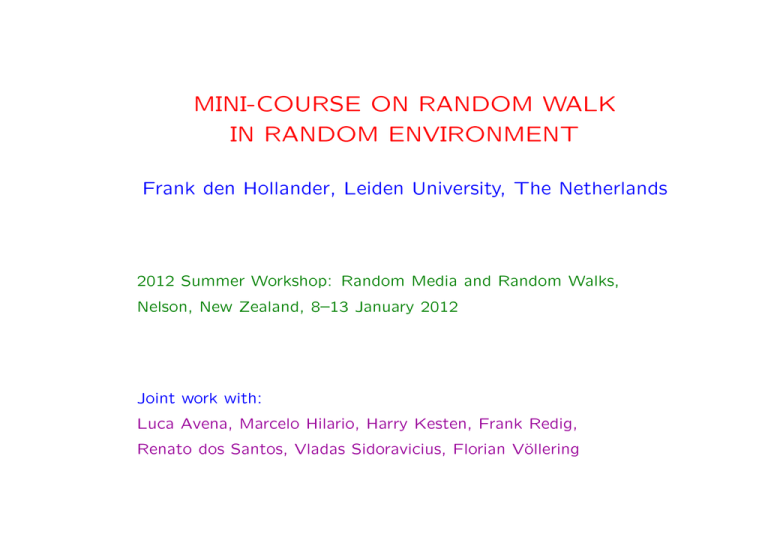
MINI-COURSE ON RANDOM WALK
IN RANDOM ENVIRONMENT
Frank den Hollander, Leiden University, The Netherlands
2012 Summer Workshop: Random Media and Random Walks,
Nelson, New Zealand, 8–13 January 2012
Joint work with:
Luca Avena, Marcelo Hilario, Harry Kesten, Frank Redig,
Renato dos Santos, Vladas Sidoravicius, Florian Völlering
CONTENT:
Lecture 1: RW + RWSRE
Lecture 2: RWDRE what we know!
Lecture 3: RWDRE what we would like to know!
RW = random walk, RE = random environment,
S = static, D = dynamic.
In what follows we will restrict ourselves to one-dimensional nearestneighbor random walks in continuous time. Higher dimensions are very
interesting, but are beyond the scope of this mini-course.
Lecture 1:
RANDOM WALK
The nearest-neighbor continuous-time random walk on Z
is the Markov process X = (Xt )t≥0 starting from X0 = 0
with transition rates
1−p
y
x−1
p
y
x
y
x+1
where p ∈ (0, 1) is the bias parameter. All properties of X
can be obtained via direct computation.
RECURRENCE VERSUS TRANSIENCE:
X is
recurrent
when p = 1
2,
transient
when p 6= 1
2.
STRONG LAW OF LARGE NUMBERS:
lim t−1Xt = v
t→∞
a.s.
with
v = p − (1 − p) = 2p − 1.
In particular, X has zero speed when it is recurrent and
non-zero speed when it is transient.
CENTRAL LIMIT THEOREM:
Xt − vt
√
= N (0, 1)
lim LAW
t→∞
t
with N (0, 1) the standard normal distribution. In particular,
X is
diffusive for all p.
The convergence in law even holds on path space, with
standard Brownian motion as the limiting process.
LARGE DEVIATION PRINCIPLE:
1
log P (Xt = ⌈θt⌉) = −I(θ),
lim
t→∞ t
θ ∈ R,
with
c(θ) + θ
− c(θ) + 1,
I(θ) = θ log
2p
where
c(θ) =
q
θ 2 + 4p(1 − p)
is the number of steps per time unit needed to realize the
displacement θ per time unit.
Picture of the rate function:
I(θ)
v
2p − 1
θ
RANDOM WALK IN
STATIC RANDOM ENVIRONMENT
RWSRE is the generalization of RW in which the transition
rates are random themselves. Our focus will be on twostate SRE.
1. SRE. Let
ξ = {ξ(x) : x ∈ Z} ∈ Ω = {0, 1}Z,
be an i.i.d. random sequence with marginal law
P(ξ(x) = 1) = ρ,
P(ξ(x) = 0) = 1 − ρ,
where ρ ∈ (0, 1) is the density parameter. We may think
of 1 and 0 as representing a particle, respectively, a hole
and we write P to denote the law of ξ.
A typical realization of ξ looks like
··· 1 1 0 0 1 1 1 0 1 1 0 0 0 0 1 1 1 0 0 0 1 ···
2. RWSRE. Given ξ, the transition rates of X on a particle,
respectively, a hole are:
1−p
p
1−p
p
-
1
-
0
Note that the rates on 0 are the reverse of the rates on 1.
We write P ξ to denote the law of X for fixed ξ.
Without loss of generality we may assume that
1,
ρ≥2
1.
p>2
RWSRE has been a highly active area of research
since the early 1970’s. It is part of the larger area
of disordered systems.
In one dimension our understanding of RWSRE is fairly
complete. Most results can be derived by solving random
recursion relations.
In higher dimensions (not treated in this mini-course) many
important results have been obtained with the help of the
technique of regeneration times, but there are still some
very hard unsolved problems.
Overview papers:
Sznitman 2002, Zeitouni 2004
What makes RWSRE particularly interesting is
that new phenomena occur due to slow-down
in space pockets.
The random walk gets trapped for long periods of time
between long strings of particles and holes:
−→
←−
1111111100000000
RECURRENCE VERSUS TRANSIENCE:
Solomon 1975
It turns out that X under P ξ is, for almost all ξ,
recurrent
when ρ = 1
2,
transient
1.
when ρ > 2
PROOF: Let
px(ξ) = pξ(x) + (1 − p)[1 − ξ(x)],
a(ξ) = P ξ (τ−1 < ∞).
Then we have the recursion relation
a(ξ) = [1 − p0(ξ)] + p0(ξ) a(σξ) a(ξ),
where σ is the left-shift acting on ξ. Let
qx(ξ) =
1 − px(ξ)
,
px(ξ)
b(ξ) = 1 − a(ξ).
Then the recursion relation can be rewritten as
1
1
= 1 + q0(ξ)
.
b(ξ)
b(σξ)
The latter can be iterated to give
y−1
x Y
X
1
=1+
qx(ξ).
b(ξ)
y=1 x=0
By the SLLN for ξ, we have
y−1
1 X
log qx(ξ)
lim
y→∞ y
x=0
1−p
p
= ρ log
+ (1 − ρ) log
p
1−p
1−p
a.s.
= (2ρ − 1) log
p
Hence b(ξ) = 0 a.s. when p = 1
2 and b(ξ) > 0 a.s. when
1 . QED
p≥2
STRONG LAW OF LARGE NUMBERS:
Solomon 1975
It further turns out that, for almost all ξ,
lim t−1Xt = v
t→∞
P ξ -a.s.
with a non-random speed given by
v=
0
(2p − 1)
ρ−p
ρ(1−p)+(1−ρ)p
1 , p],
when ρ ∈ [ 2
when ρ ∈ (p, 1].
Note that if p > 1
2 , then v < (2p − 1)(2ρ − 1), which is the
speed of the RW with average transition rates.
Phase diagram for RWSRE in the (p, ρ)-plane:
1
v>0
transient with non-zero speed
ρ
transient with zero speed
v=0
1
2
p
1
recurrent
CENTRAL LIMIT THEOREM:
Also the scaling behavior for RWSRE shows a richer behavior than for RW.
In the recurrent regime the scaling is extremely subdiffusive:
(log t)−2 Xt has a non-degenerate limit law
under the joint law of (ξ, X).
Sinai 1982, Kesten 1986
In the transient regime the scaling and is controlled by the
quantity
s=
log( 1−ρ
ρ )
log( 1−p
p )
∈ (0, ∞).
It turns out that X is
diffusive
superdiffusive
subdiffusive
1 and s ∈ (2, ∞),
when s = 2
when s ∈ ( 1
2 , 2],
when s ∈ (0, 1
2 ).
The scale depends on s. In the latter two cases the limit
law is a stable law under the joint law of (ξ, X).
Kesten, Kozlov, Spitzer 1975
1
diff
ρ
supdiff
subdiff
1
2
p
1
LARGE DEVIATION PRINCIPLE:
Also the large deviation rate function for RWSRE shows a
richer behavior than for RW.
It turns out that, for almost all ξ,
1
log P ξ (Xt = ⌈θt⌉) = −I(θ),
t→∞ t
lim
θ ∈ R,
with I(θ) given by a variational formula that is non-random
and can be solved in terms of a random continued fraction.
Greven, dH 1994
Picture of the rate function in the transient regime with
non-zero speed:
I(θ)
v
−v
v
v
0
v
θ
The flat piece shows that slow-down in speed is not exponentially costly. There is also a symmetry property:
p
I(−θ) = I(θ) + θ(2ρ − 1) log
,
1−p
θ ≥ 0.
Lecture 2:
RANDOM WALK IN
DYNAMIC RANDOM ENVIRONMENT
What we know!
RWDRE is the variant of RWSRE where the random transitions rates evolve with time.
The state of the art for RWDRE is modest. In
fact, RWDRE has started to develop properly only
since 2000. Presently there are some 30 papers
in the mathematics literature.
Three classes of DRE have been considered so far:
1. Independent in time: globally updated at each unit of time.
2. Independent in space: locally updated according to independent single-site Markov chains.
3. Dependent in space and time.
Only few papers fall into class 3, which is the most challenging. Most of these require additional assumptions,
such as:
• Fast decay of the space-time correlations in the DRE.
• Weak effect of the DRE on the RW (= perturbative
regime).
Time can be viewed as an extra dimension. However, since
time is directed, it plays a different role than space (nonellipticity).
RWDRE is harder to analyze than RWSRE, because it
interpolates between RWSRE and RW:
• The limit of slow-dynamics is RWSRE.
• The limit of fast-dynamics is RW with average transition
rates.
So far the focus has been on a few classical choices of
DRE:
• Spin-flip systems
(stochastic Ising model, contact process, voter model).
• Exchange systems
(exclusion process).
MAIN QUESTION:
Does the dynamics destroy the slow-down in pockets
present in the static situation? Are there interesting
new phenomena?
1. DRE. Let
ξ = (ξt )t≥0,
ξt = {ξt(x) : x ∈ Z} ∈ Ω = {0, 1}Z,
be a one-dimensional interacting particle system, where
ξt(x) = 1/0 means that site x carries a particle/hole at
time t.
Suppose that ξ has an equilibrium measure µ on Ω that is
shift-invariant and shift-ergodic. Write Pµ to denote the
law of ξ starting from µ. Write ρ to denote the particle
density under µ.
2. RWDRE. Given ξ, the transition rates of X are
x → x + 1 at rate p ξt(x) + (1 − p) [1 − ξt(x)],
x → x − 1 at rate (1 − p) ξt(x) + p [1 − ξt(x)].
1−p
p
p
-
1
1−p
-
0
A typical realization of ξt looks like
··· 1 1 0 0 1 1 1 0 1 1 0 0 0 0 1 1 1 0 0 0 1 ···
but now evolves in time. Without loss of generality we
1 and p > 1 .
may again assume that ρ ≥ 2
2
DEFINITION: Pµ is said to be cone-mixing if, for all θ ∈
1 π),
(0, 2
lim
sup
t→∞ A∈FZ×{0}
B∈FC (t)
θ
Pµ(B|A) − Pµ(B) = 0,
where F stands for sigma-algebra.
time
Cθ (t)
cone
Z × {0}
-
θ θ
x
t
Comets, Zeitouni 2004
RWSRE regeneration times
-
x x x x x x x
space
THEOREM: [SLLN under cone-mixing]
If Pµ is cone-mixing, then limt→∞ Xt /t = v P ξ -a.s. for almost all ξ.
No information is available on the sign of v. It is tempting
to conjecture that
=0
v
>0
if ρ = 1
2,
if ρ > 1
2.
The reason why this conjecture is non-trivial is that for
RWSRE the crossover between v = 0 and v > 0 occurs at
1.
ρ = p instead of ρ = 2
EXTENSIONS:
• CLT under a multiple cone-mixing condition.
Avena, dos Santos, Völlering 2011
• SLNN for long-range random walks under a conditional
cone-mixing condition.
dH, dos Santos, Sidoravicius 2011
WHAT ABOUT SPIN-FLIP SYSTEMS?
Suppose that ξ is a spin-flip system with flip rates
x ∈ Z, η ∈ Ω,
c(x, η),
where c(x, η) is the rate at which the spin at site x flips in
the configuration η.
Suppose that the flip rates are shift-invariant, and let
M =
X
sup |c(0, η) − c(0, η x)|,
x∈Z\{0} η∈Ω
ǫ = inf [c(0, η) + c(0, η 0)].
η∈Ω
These are to be thought of as measuring the maximal
dependence, respectively, the minimal noise in the system.
THEOREM: [SLLN for spin-flip systems]
If Pµ satisfies M < ǫ and 0 < 2p − 1 < 1
2 (ǫ − M ), then
v = (2p − 1)(2ρ̃ − 1)
with
ρ̃ =
∞
X
(2p − 1)ncn,
n=0
where c0 = ρ and cn, n ∈ N, are functions of Pµ that are
given by a recursive relation.
The condition M < ǫ is a space-time Dobrushin condition,
and guarantees exponentially fast decay of space-time correlations in the random environment.
Additional facts:
1. c1 = 0 when Pµ is reversible.
2. c1 = 0, c2 < 0 for ρ > 1
2 when Pµ is the law of
independent spin-flips.
The latter says that the speed of RWDRE is strictly smaller
than that of RW, so some form of slow-down is present.
DEFINITION: A shift-invariant spin-flip system is attractive when for all η ≤ ζ
c(0, η) ≤ c(0, ζ) if η(0) = ζ(0) = 0,
c(0, η) ≥ c(0, ζ) if η(0) = ζ(0) = 1.
Attractive means that 0’s tend to induce more 0’s and 1’s
tend to induce more 1’s.
The stochastic Ising model, the voter model and the contact process are all attractive.
THEOREM: [LDP for attractive spin-flip systems]
(a) Suppose that Pµ is attractive. Then for almost all ξ
1
log P ξ (Xt = ⌈θt⌉) = −I(θ),
θ ∈ R,
t→∞ t
with θ 7→ I(θ) a non-random convex rate function whose
zero set is
lim
[v−, v+]
for some
−(2p − 1) ≤ v− ≤ v ≤ v+ ≤ 2p − 1.
(b) lim|θ|→∞ I(θ)/|θ| = ∞.
(c) If M < ǫ and 0 < 2p − 1 < 1
2 (ǫ − M ), then
v− = v = v+ .
Picture of the rate function:
I(θ)
x
v−
θ
x
v+
THEOREM: [symmetry property]
p
I(−θ) = I(θ) + θ(2ρ − 1) log
,
1−p
θ ≥ 0.
Lecture 3:
RANDOM WALK IN
DYNAMIC RANDOM ENVIRONMENT
What we would like to know!
WHAT ABOUT EXCHANGE SYSTEMS?
In what follows we consider the exclusion process, i.e., a
collection of independent simple random walks jumping at
rate 1 subject to hard-core repulsion.
Due to the presence of particle conservation, the exclusion
process is neither cone-mixing nor attractive, so none of
the above theorems applies. Nevertheless, both the SLLN
and the LDP are expected to hold.
SLLN: SIMULATION FOR EXCLUSION PROCESS
In the figures below, four speeds are computed via simulation as a function of p and ρ:
(1) static speed
(2) static simulated speed
(3) dynamic simulated speed
(4) average medium speed
Each simulation is based on 103 initial configurations and
104 steps of the exclusion process and the random walk,
both running in discrete time.
Speed as a function of p for ρ = 0.8.
From bottom to top:
(1) static speed
(2) static simulated speed
(3) dynamic simulated speed
(4) average medium speed
Speed as a function of ρ for p = 0.7.
From bottom to top:
(1) static speed
(2) static simulated speed
(3) dynamic simulated speed
(4) average medium speed
LDP: SLOW-DOWN
Conjectured picture of the rate function for the exclusion
process:
I(θ)
x
x
−v
0
x
v
θ
The only result proven so far is that I ann(0) = 0. The key
idea is the following traffic jam estimate.
LEMMA: There exist A, δ > 0 such that, for all t ≥ 1
and all intervals Q, Q′ ⊂ Z separated by a distance at least
√
2 t log t,
Pµ ξs(x) = 1, ξs(y) = 0 ∀ x ∈ Q ∀ y ∈ Q′ ∀ s ∈ [0, t]
√
′|) t
−A(|Q|+|Q
.
≥ δe
1111
1111
1111
1111
1111
Q
√
2 t log t
-
0000
0000
0000
0000
0000
Q′
↑ time
→ space
The above lemma implies that slow-down pockets of size
|Q| = |Q′| = B log t in the exclusion process survive up
to time t with a probability that decays not faster than
√
δ exp[−2AB t log t].
When B is large enough (depending on p), such pockets
trap the random walk up to time t with a probability that
tends to 1 as t → ∞. Consequently,
Eµ P
ξ
p
Xt = O( t log t)
≥e
√
−O( t log t)
.
EXTENSIONS:
• SLLN for random walks on an exclusion process with a
large enough positive drift on both particles and holes.
Avena, dos Santos, Völlering 2011
• SLLN for random walks on a Poisson random field of
independent simple random walks.
dH, Kesten, Sidoravicius 2011
Hilario, dH, Sidoravicius [in progress]
WHAT IF THE DRE IS SLOW OR FAST?
Avena, Thomann 2011
Allow ξ to evolve at rate γ ∈ (0, ∞). Three parameters:
(p, ρ, γ).
Simulations carried out for the exclusion process show an
interesting dependence on (p, ρ, γ) of both the speed in the
SLLN and the scaling in the CLT.
SLLN:
Speed as a function of ρ for p = 0.8 and γ between 10−3
(lower curve) and 10 (upper curve).
SLLN:
Speed as a function of p for ρ = 0.8 and γ between 10−4
(lower curve) and 10 (upper curve). The curves labelled
γ1(ρ) and γ2(ρ) indicate a change of shape.
CLT:
Phase diagram as a function of (p, ρ, γ). The colors indicate
the regions of (sub/super)diffusive scaling.
CLT:
Two sections of the phase diagram for fixed ρ (left) and
fixed p (right).
The simulations for the exclusion process show that:
• For small γ the phase diagram is qualitatively similar
to that of RWSRE.
• For large γ the phase diagram is qualitatively similar to
that of RW with average transition rates.
• The ratio γ of the jump rates of ξ and X determines
whether or not subdiffusive or superdiffusive behavior
is possible for some choice of (p, ρ).
Avena, Thomann 2011
For independent spin-flips simulations indicate that only
diffusive behavior is possible.
Apparently, the fact that the exclusion process is conservative is important for the anomalous scaling. This is another
manifestation of the slow-down phenomenon.
HARD CHALLENGE:
Prove any(!) of the properties suggested
by the above simulations.
Perhaps a perturbation argument for small γ is feasible:
RWSRE perturbed by a very slow dynamics.
